Case Examples
Decarbonization Efforts
Product Development Stage: Environmentally-Friendly Product Development
- Materials
- Design
Toyoda Gosei Launches Large High Pressure Hydrogen Tank for Commercial Vehicles
Toyoda Gosei Co., Ltd. has launched a large high pressure hydrogen tank. Delivery trucks travel long distances and make multiple deliveries each day, and so need to have a long driving range and fast refueling. Fuel cell trucks meet these needs and are expected to come into greater use. Toyoda Gosei will contribute to a hydrogen society through the development and production of hydrogen tanks that are a crucial component of fuel cell vehicles.
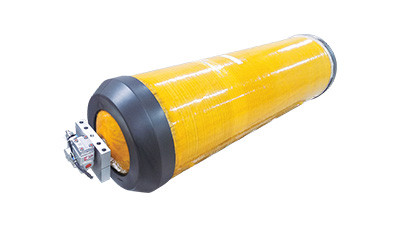
Large high pressure hydrogen tank
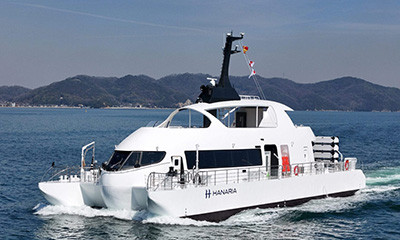
CJPT’s mass market small fuel cell truck

Toyoda Gosei’s efforts for a hydrogen society
Toyoda Gosei products and technologies used on Lexus environmentally-friendly off-road vehicle
Toyoda Gosei’s hydrogen tanks and plastic recycling technology have been adopted in LEXUS’s first recreational off-highway vehicle (ROV) equipped with a hydrogen engine, started by Lexus International (LEXUS).
The hydrogen fuel is stored in Toyoda Gosei’s high-pressure hydrogen tank, which features both high airtightness that seals in hydrogen and high pressure resistance to efficiently store hydrogen. In exterior plastic parts, recycled materials from end-of-life vehicle bumpers are used to achieve “horizontal recycling” that reuses scrapped parts in new vehicles.
The application of recycled materials to automobile parts with high quality standards has been done using Toyoda Gosei’s material technology to strengthen recycled materials with the use of a biomaterial (cellulose nanofiber or CNF, which is five times stronger than steel).
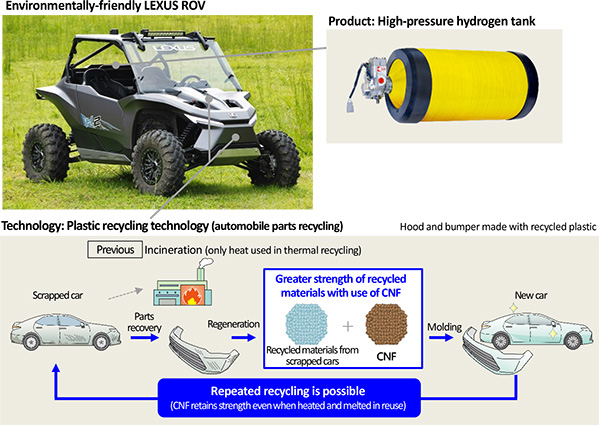
Toyoda Gosei Environmental Products Used on New Toyota Crown Sedan
Toyoda Gosei Co., Ltd.’s high-pressure hydrogen tank and topcoat-less hot-stamped grille have been adopted for use on new Crown sedan launched from Toyota Motor.
The fuel cell electric vehicle (FCEV) model of the Crown sedan is equipped with high-pressure hydrogen tanks to store the hydrogen fuel. A Toyoda Gosei high-pressure hydrogen tank is used in the rear of the vehicle.
The front grille features metallic spot decoration with hot-stamping. * Toyoda Gosei’s topcoat-less, hot-stamping technology reduces CO2 emissions during production by 20%. Hot-stamping of surfaces with large curves is also achieved with the company’s precision processing technology.

Toyoda Gosei Puts Cellulose Nanofiber-Reinforced Plastic for Automotive Parts into Practical Application
Toyoda Gosei has made lightweight product transport containers using a cellulose nanofiber (CNF)-reinforced plastic1 it developed for interior and exterior automotive products.
CNF-reinforced plastic is a beneficial material for the aims of decarbonization and a recycling society; when CNF is mixed into plastic as a reinforcing material, it makes automotive parts lighter in weight and easier to recycle.
Toyoda Gosei mixed CNF with recycled material from old polypropylene containers that were no longer in use to make containers that were 6% lighter in weight. Compared with the previous containers, CO2 will be reduced by 6% over the entire lifecycle.*1
- *1 The trial calculations were made assuming the containers will be used in product transport for four years.
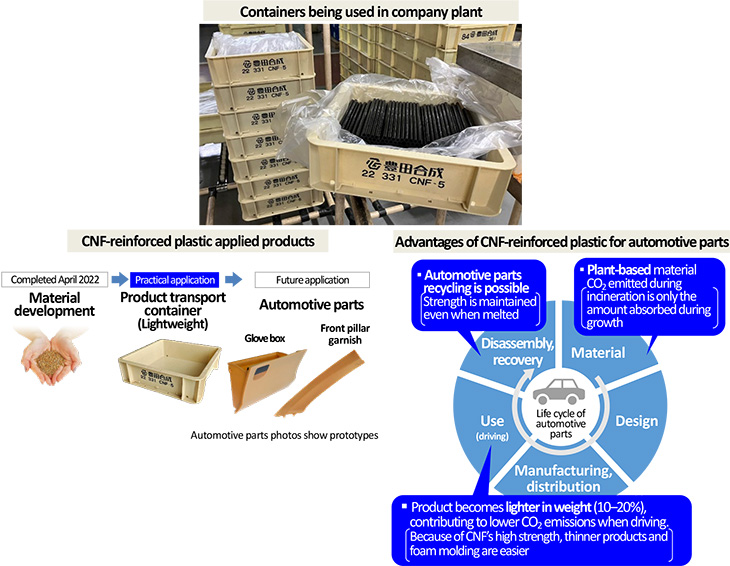
Production Stage: Emission Reduction through Development of New
Manufacturing Methods and Day-to-Day Improvements
- Manufacturing
Toyoda Gosei and Toyota Central R&D Labs Jointly Develop Technology to Reduce the Amount of Steam Used in Manufacturing Rubber Products
Toyoda Gosei Co., Ltd. and Toyota Central R&D Labs., Inc. have jointly developed new technology that reduces the amount of energy used in the production of rubber products.
After rubber automotive hoses are formed, they are put in an autoclave and heated with high temperature steam to give them elasticity. During this process, large amounts of steam are used to raise the temperature to a fixed level. Much gas is consumed to create this steam. To reduce the amount of steam used, Toyoda Gosei focused on the process of exchanging the air inside the autoclave with steam and leveraged Toyota Central R&D Labs’ simulation technology that can analyze with high accuracy the airflow and heat distribution within the autoclave. The new, energy-saving technology, under joint patent pending, reduces by half the amount of steam needed during discharge compared with the previous process. The company plans to roll out application of this technology to its other rubber parts plants in Japan and internationally.
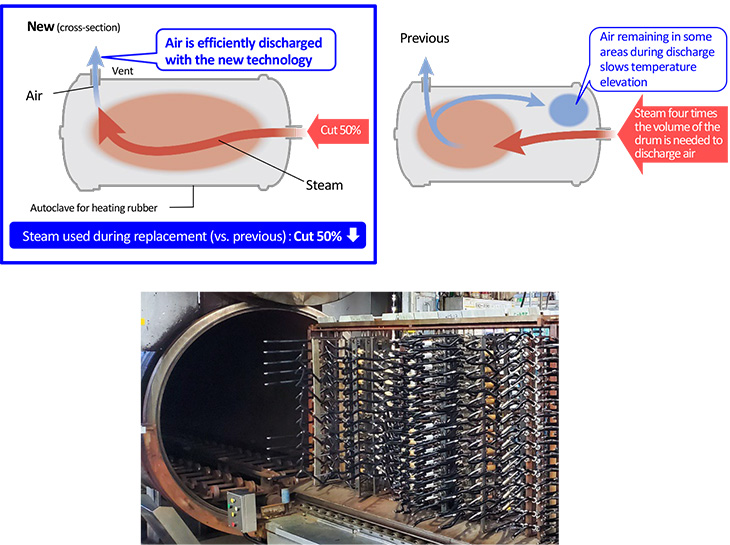
Autoclave for heating with steam (back) and rubber hoses (front)
Renewable Energy Introduced at Toyoda Gosei Memorial Gymnasium
Toyoda Gosei Co., Ltd. has switched to renewable energy*2 for the electricity used in sports games and other events at the Toyoda Gosei Memorial Gymnasium (Aichi Prefecture, Japan). This will cut CO2 emissions by about 180 tons in FY2023 compared with the previous year.
In August 2023, Toyoda Gosei set a new target of achieving carbon neutrality by 2030, and is saving energy through production technology innovations and continuous daily improvements, as well as switching to renewable energy. For the latter, Toyoda Gosei is increasing use of renewable energy with the best combination of on-site solar systems, green power, non-fossil certificates,*3 and other measures.
In addition to power from existing solar panels at the Toyoda Gosei Memorial Gymnasium, the company will switch to renewable energy (400 MWh annually) using non-fossil certificates with tracking, which certify the environmental value derived from solar power generated within Aichi Prefecture, Japan.
- *2 Energy from natural sources such as sun, wind, biomass, etc.
- *3 Certification of the value of renewable energy that does not emit CO2 (environmental value).
Roadmap for CO2 reductions by 2030(Changes from original plan)

Current efforts to adopt renewable energy
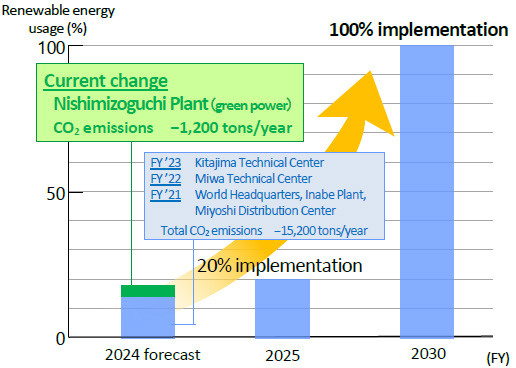
Solar power generated in Aichi Prefecture
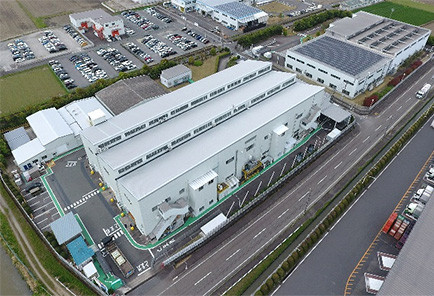
Toyoda Gosei Memorial Gymnasium (ENTRIO)
Logistics Stage: Improving Loading Efficiency
- Design
- Manufacturing
Toyoda Gosei Improves Truck Loading Efficiency With the Use of AI, Reducing CO2 Emissions
Toyoda Gosei Co., Ltd. has developed a system that automatically calculates truck load volumes to raise transport efficiency during product delivery, and has begun operating this system at its Miyoshi Distribution Center (Aichi Prefecture, Japan). This will make it possible to eliminate about 4,400 shipments annually, which is anticipated to reduce CO2 emissions by 140 tons.
Routes and shipments with low loading are easily identified, which has led to improved transport efficiency; on some routes where the trial was conducted, the number of shipments was reduced from 15 to 12 per day. Logistics plans with little waste not only reduce CO2 emissions from product transport, but will also help to alleviate the truck driver shortage that has become a social issue in Japan.
Key improvements for greater transport efficiency

Toyoda Gosei Participates in a Trial of Renewable Diesel Fuel, an Alternative to Petroleum-Based Diesel Fuel
Group company TG Logistics Co., Ltd. participated in a field trial to demonstrate the utility of renewable diesel fuel (RD fuel), an alternative diesel fuel for trucks.
RD fuel is manufactured from used cooking oil and other sources and can cut CO2 emissions by 90% compared with petroleum-derived fuel. The CO2 emitted during use is equivalent to the amount of CO2 absorbed during the growth of the plants that serve as the raw materials of these cooking oils, and so the total amount of CO2 in the atmosphere is not increased. RD fuel can also be introduced without changes to the vehicles or refueling systems, and so is promising for greater use in the transport field.

Truck (11 tons) that uses RD fuel
Materials and Parts Procurement Stage: Emission Reduction through Collaboration with Suppliers
- Materials
- Manufacturing
Opening of “Energy Saving Dojo” and sharing case examples with suppliers
Toyoda Gosei’s Energy Saving Dojo was established in the Miwa Technical Center as an educational facility where cases of energy savings on production lines and the elimination of waste are shared within the company. Suppliers and others share good examples of efforts to cut CO2 over the entire supply chain.
Toyoda Gosei aims to achieve carbon neutrality in production activities by saving energy through reduced consumption of electric and thermal energy in plants (decrease in the total amount of energy used) and by raising the adoption rate of renewable energy such as solar and wind energy (switching energy sources).
The Energy Saving Dojo exhibits a total of 15 case examples, including an area where visitors can compare the energy-saving effect of heat pumps with heaters, examples of power loss due to leaks of air sent from air compressors and the length of piping, and the new technology of thermoelectric power generation, which can convert waste heat from equipment into electric power, that is being jointly developed with E-ThermoGenTek Co., Ltd.

Energy Saving Dojo

Suppliers learning about cases of energy savings
Efforts for a Recycling-Oriented Society
Reduction of Waste Materials in the Production Stage
- Manufacturing
- Collection/recycling
Waste reduction from design of airbag pads that can be easily
taken apart*4
Previously, the pad and metal were riveted and caulked. As a result, when there was a problem the product could not be taken apart and it all had to be disposed of as waste, including good components. By switching to a fixation method that allows for easy dismantling while maintaining quality, and for separation of each material component (plastic pad, cloth, metal), waste was reduced by about 8.5 tons as a result of recycling and converting waste into valuables. We will continue reducing waste with similar approaches.
- *4 The ability to easily dismantle various parts

Mottainai inspection
To eliminate waste of resources, we have performed plant inspections and regular mottainai inspections for corrective treatment since 2018.
Since 2021, production engineering departments have also been involved in the inspections, and executives in charge of the environment and leaders of each plant perform the inspections with a focus on places where remnants and waste materials generated in production processes are kept. The thoroughness of sorting and kaizen for recycling are investigated.
 Mottainai inspection / InazawaPlant
Mottainai inspection / InazawaPlant
Development of Product Recycling Technology
- Materials
- Design
- Manufacturing
- Collection/recycling
Full-Scale Operation of Rubber Recycling Processes
In April 2021, recycling processes for four types of weatherstrips were brought together in a dedicated building. By restoring waste rubber to a raw material state with our original technology and using it in new products, we expect to reduce waste by about 600 tons. This should also have an effect in reducing CO2 emitted during raw material transport and the incineration of waste. In addition, we hope to contribute to reducing the environmental impacts of the industry overall, by using this recycled rubber not only inhouse but also selling it to other companies.
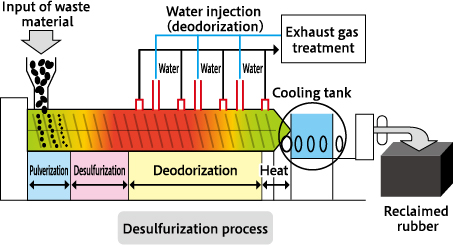
Development of Technology for End-of-Life Vehicle Parts Recycling
Development of products that use material remnants
We are developing products using rubber remnants and recycled materials, and have developed a floor mat that reduces fatigue during work in factories. We have also developed ecobags and other products using airbag remnants, and have begun selling them under the “Re-S” brand name.

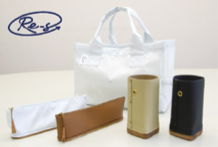

Re-S comes from “Re-born” and “Re-cycle,” which start with the letters “Re,” and from the increased sustainability (S) by implementing environmentally-friendly initiatives.
Reducing Water Risks
- Manufacturing
Wastewater treatment facility at Morimachi Plant upgraded
The wastewater treatment facility for production processes at the Morimachi Plant, which had been in use for more than 30 years, was upgraded in FY2018. With the adoption of more advanced processing (membrane bioreactor) and a constant monitoring system, a cleaner and more stable water quality than before is achieved in wastewater.

Reduced water usage with the use of rainwater
Toyoda Gosei’s Memorial Gymnasium (Aichi, Japan) and Group company Hoshin Gosei Co., Ltd. reduced water usage by recirculating water in production processes, installing green curtains, and using rainwater to water plants in employee rest spaces.

Use of rainwater at Toyoda Gosei’s Memorial Gymnasium
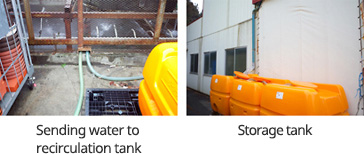
Rainwater use at Toyoda Gosei Group companies
Efforts for an Environmentally-Friendly Society
Major activities for biodiversity 1
Woodland maintenance
“Toyoda Gosei Kimorino Sato”
Minokamo, Gifu Prefecture, located on the upper reaches of the Kiso River
“Mutsumi no Sato”
Woodland on grounds of Toyoda Gosei’s Morimachi Plant. Morimachi, Shuchigun, Shizuoka, Japan
Undergrowth is cleared and trees are thinned to create rich woodlands in two rented mountain forest areas.
 Kimori no Sato / Minokamo City, Gifu, Japan
Kimori no Sato / Minokamo City, Gifu, Japan
 Tree-thinning work
Tree-thinning work
 Mutsumi no Sato / Morimachi,
Mutsumi no Sato / Morimachi,
Shuchigun, Shizuoka, Japan
Biotope Creation on Company Grounds Using a Regulating Pond
Currently, about 95 species of plants and animals have formed an ecosystem. This project was registered in the Ministry of the Environment’s Nature Symbiosis Site*5 program last November.
- *5 This system, in which the Ministry of the Environment certifies privately-owned lands and other areas where attempts are being made to protect biodiversity, accords with the international goal of “30 by 30” (protection of 30% of land and ocean area by 2030)
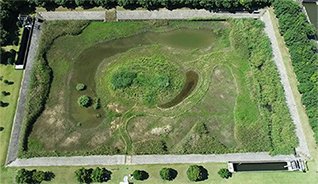
Heiwacho Plant biotope

Monitoring investigator
Major activities for biodiversity 2
Participation in cleanup activities for the Fujimae Tidal Flat
Twice a year, employees and their families pick up polystyrene foam, plastic bottles and other trash that has been thrown up on the banks of the Fujimae Tidal Flat due to typhoons or other phenomena, to protect its ecosystem. The Fujimae Tidal Flat is located in Nagoya and is registered in the Ramsar Convention.*6 This provided an opportunity for participants to think about the environment, including understanding that birds and fish sometimes die from eating such trash and observing the animals (crabs, mudskippers, clams) that live in the tidal flat, which is not normally open to the public. This cleanup activity is held every year in cooperation with local residents and an NPO.
- *6 An international treaty on the preservation and regeneration of wetlands that are waterfowl habitats. It was adopted in Ramsar, Iran in 1971.
 Activity participants
Activity participants
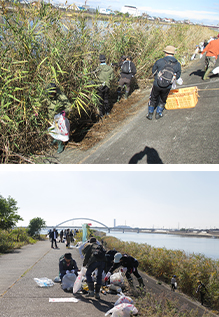 Participants in action
Participants in action
Participation in eradication activities
Toyoda Gosei participated together with Konan City and other local companies in an activity to get rid of Lance-leaved Coreopsis,*7 an invasive alien plant species. This was done with the aim of protecting native plant species, and will be continued in cooperation with community residents.
- *7 This flower was imported into Japan from overseas as an ornamental plant, but it propagates strongly and crowds out native species. It was recently classified as a designated invasive species, and its cultivation and sale are prohibited.
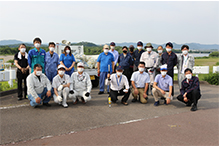 Activity participants
Activity participants
 Participants in action
Participants in action
Environmental Management Efforts
Opening of Environment Learning Center (ELC)
This center was opened as a permanent place where young employees and environmental novices can raise their environmental awareness, gain basic environmental knowledge, and learn about efforts within the company.
Trends in global environmental activities and company efforts are introduced in an easily understandable manner through illustrations, videos, and experiential exhibits. Examples of production process energy savings and waste reduction and ecosystem protection are displayed so that visitors can apply them in their own workplaces. The company intranet is also used so that more employees can view these online at any time. They are also presented on a smartphone site for employees.
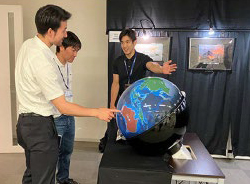
Tour of exhibit

Education for young employees
Solicitation of “Mottainai senryu”
(Environment Month)
With the aim of raising environmental awareness, senryu verses are solicited from all employees of the TG Group with the theme of “Mottainai” (“What a waste!”) related to energy, resources and time in one’s surroundings. A total of six people were awarded from among representative works selected in each department and company, including one Gold Prize. Submissions were also posted on the company’s internal website to raise environmental awareness.
| Senryu verses |
|---|
| Increase The ways of use Not the amount of trash |
| Making too much Is a waste Of both materials and time! |
| Food loss Throws away the hard work Of producers |
| Environmental awareness Is an environmental investment In your own future |
| Forget your water bottle Turn back Home to get it |
| The earth’s future Is also being thrown away In the trash can |
This year’s outstanding works
Copyright for the text and images used in this website belongs to Toyoda Gosei Co., Ltd. They may not be copied or transferred without the permission of Toyoda Gosei.
- Contributing to Environmental Preservation Through All Our Business Activities
- Environmental Action Plan
- Building Decarbonized Societies
- Building Circular Societies
- Environmental Preservation and Building Environmentally-Friendly Societies
- Environmental Management
- Collaboration with External Organizations
- Environmental Efforts at Affiliated Companies
- Environmental Data
- Third-Party Verification
- TCFD
- Third-Party Assessment
